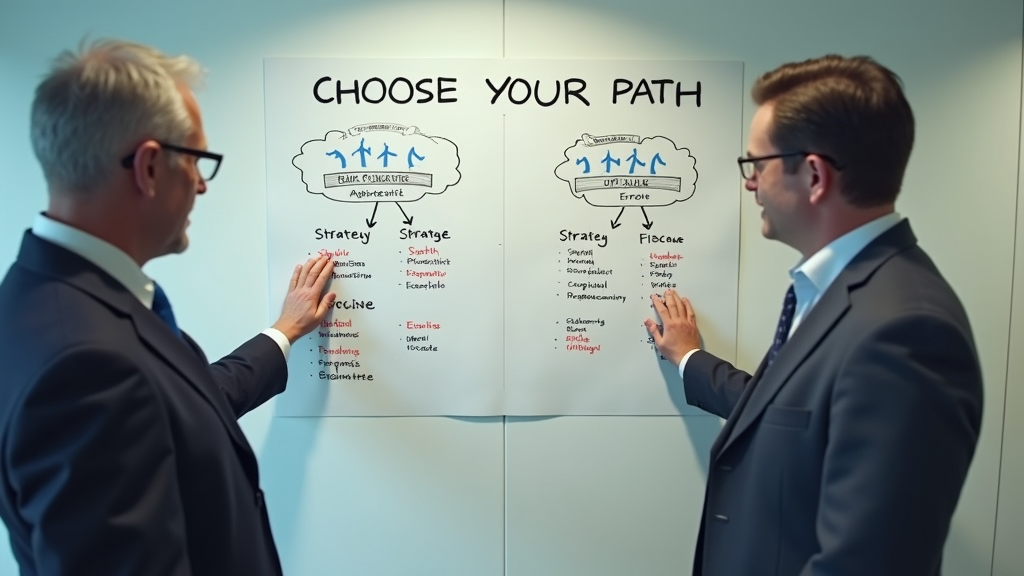
Introduction
Marketing B2B SaaS products comes with its own set of challenges. You need to explain complex features to busy professionals while competing with hundreds of similar solutions. Your potential customers often need months to make a decision, and your product keeps changing with new updates. Plus, you have to keep current customers happy while bringing in new ones.
Getting more customers for your SaaS business doesn't have to be complicated. We've studied what works and what doesn't across successful SaaS companies. Our guide shows you proven marketing strategies that actually bring results. We'll share real numbers and examples from companies that grew their customer base, plus clear steps you can follow for your own business. No fancy jargon or confusing theories, just practical methods you can start using today.
Understanding SaaS Marketing Fundamentals
Software as a Service (SaaS) marketing focuses on promoting subscription-based software products to potential customers. Unlike regular product marketing, you're selling access to software that customers will use regularly. This ongoing relationship means you need to prove value continuously, not just during the initial sale.
Traditional marketing methods often fall short for SaaS products because they focus too much on one-time purchases. Your customers aren't buying a physical product they can hold or see right away. Instead, they're investing in a solution they'll use over time. This means you need to show them how your software will solve their problems and make their work easier month after month.
Understanding SaaS marketing metrics helps you make better decisions about your marketing strategy. Customer Acquisition Cost (CAC) shows how much you spend to get each new customer. Lifetime Value (LTV) tells you how much revenue you can expect from a typical customer over time. Churn rate reveals how many customers stop using your service. These numbers work together to show if your marketing efforts are paying off and where you might need to improve. By tracking these metrics, you can adjust your strategy to get better results and grow your business more effectively.
Building Your SaaS Marketing Strategy
Your SaaS marketing strategy starts with understanding who will use your product. Create customer personas by talking to current customers or surveying your target market. Find out their job roles, daily challenges, and what makes them interested in solutions like yours. These insights will guide your marketing decisions and help you speak directly to your ideal customers.
- Clear Value Proposition: Write down how your product solves specific problems for customers
- Market Position: Figure out what makes your product different from other options
- Competition Research: Learn what similar products offer and where you can stand out
- Marketing Channels: Pick the platforms where your potential customers spend their time
- Budget Planning: Set clear spending limits for each marketing activity
- Success Metrics: Choose which numbers will show if your marketing works
Your marketing plans should work together with your product updates. When you release new features, your marketing can highlight them. If customers ask for specific improvements, your marketing can show how you listen and respond to feedback. This connection between marketing and product development helps you build trust with customers and keeps your message current with what your product actually offers.

Product Led Growth vs Marketing Led Growth
Product Led Growth (PLG) and Marketing Led Growth (MLG) are two main ways to grow your SaaS business. With PLG, your product itself brings in new users through free trials or freemium plans. Users try your product first and decide to buy based on their experience. MLG focuses on marketing campaigns and sales teams to bring in new customers. Your marketing efforts convince potential customers to buy before they use the product.
| Aspect | Product Led Growth | Marketing Led Growth |
|---|---|---|
| Customer Acquisition | Users sign up and try the product immediately | Marketing campaigns and sales conversations lead to purchase |
| Scalability | Grows naturally as users share and invite others | Depends on marketing budget and sales team size |
| Resource Requirements | Strong product development team, good onboarding | Marketing team, content creators, sales staff |
| Ideal Use Cases | Simple products that solve clear problems | Complex products that need explanation |
Your SaaS growth marketing strategy should match your product and target customers. Choose PLG if your product is easy to understand and users can see value quickly without help. Go with MLG if your product needs explanation or serves enterprise customers who prefer traditional sales processes. Many successful companies actually use both approaches, adjusting their mix based on what works best for different customer groups.
Essential SaaS Marketing Channels
Your SaaS product needs the right marketing channels to reach potential customers. The digital landscape offers many options to promote your software, and choosing the right ones will help you grow your user base effectively.
- Content Marketing: Blog posts, guides, and videos that solve your audience's problems
- SEO: Website optimization to rank higher in search results for relevant keywords
- Paid Advertising: Google Ads, social media ads, and retargeting campaigns
- Email Marketing: Newsletters, onboarding sequences, and product updates
- Social Media: Regular posts, community engagement, and brand building
You'll want to pick marketing channels that match your business model and target audience. B2B SaaS companies might benefit more from LinkedIn and content marketing, while B2C products could see better results with Instagram and paid ads. Start with one or two channels and master them before expanding your efforts.
Building an email list is crucial for any SaaS marketing strategy. FastWaitlist helps you validate your product ideas and grow your email list before launch. You can use it to capture early interest and build momentum for your product release.
Content Marketing for SaaS
Content marketing helps you build trust with potential customers before they buy your software. Your content shows them how to solve their problems and explains why your product is useful. This builds credibility and keeps people coming back to learn more.
1. Blog Posts
Write helpful articles about problems your software solves. Share tips, guides, and industry insights that your customers want to know about.
2. Whitepapers
Create in-depth reports with research and data that help businesses understand complex topics related to your software.
3. Case Studies
Show real results from your current customers. Include specific problems they faced and how your software helped them succeed.
4. Product Documentation
Write clear guides that help users understand every feature of your software. Include setup instructions and troubleshooting tips.
5. Video Tutorials
Record short videos showing how to use your software. Break down complex features into simple steps anyone can follow.
Getting your content to the right people is just as important as creating it. Share your content on social media where your customers spend time, like LinkedIn for business software. Send your best content in email newsletters to keep subscribers informed. Work with other companies in your industry to share each other's helpful content. This gets your message to more people who might need your software.

SaaS Conversion Optimization
Your SaaS conversion funnel works differently from regular ecommerce. Instead of a single purchase decision, you need to guide users through multiple steps. Users typically start with your website visit, move to a free trial or demo, and finally become paying customers. Each step needs specific attention because losing potential customers at any point affects your growth.
Getting users to convert from free trial to paid subscription requires careful planning. Your trial period should give users enough time to understand your product's value. The key is to help users reach their first success moment quickly. Send helpful onboarding emails, offer clear documentation, and provide support when needed. Think about adding progress bars or checklists to show users how close they are to getting full value from your product.
Your pricing page plays a big role in converting visitors into customers. Many SaaS marketing tools can help you test different pricing layouts and options. Show your pricing clearly and include all important features for each plan. Add social proof like customer reviews or logos of well-known clients. Make sure to highlight your most popular plan and include a clear call to action button for each pricing tier. Remember to answer common questions about billing cycles, refunds, and plan upgrades right on the page to remove any doubts.
Customer Retention Marketing
Getting new customers costs more than keeping your current ones. Your existing customers already know your product and are more likely to buy upgrades or recommend you to others. Better retention means more stable income and helps your business grow steadily over time.
Your customer's first experience with your product sets the tone for your entire relationship. A good onboarding process helps users understand your product's value quickly. You want to guide them through key features and show them how to solve their problems. Simple things like welcome emails, video tutorials, and progress tracking can make a big difference in how long customers stay with you.
Marketing and customer success teams need to work together closely. Your marketing team knows what promises were made to customers, while your customer success team sees how users actually use your product. Share information between these teams regularly. For example, if customers keep asking about a specific feature, your marketing team can create helpful content about it. This partnership helps you deliver what customers expect and need, leading to longer-lasting relationships.
Measuring SaaS Marketing Success
You need to know if your marketing efforts are working. Numbers tell you what's going well and what needs fixing in your SaaS business. By tracking the right metrics, you can make better decisions about where to spend your time and money.
Here are the key metrics you should monitor:
-
Monthly Recurring Revenue (MRR): Your monthly income from subscriptions. This shows if your business is growing.
-
Customer Acquisition Cost (CAC): The money you spend to get one new customer. This includes marketing and sales expenses.
-
Customer Lifetime Value (LTV): The total money a customer brings during their relationship with your business. Higher numbers mean better customer retention.
-
Churn Rate: The percentage of customers who cancel their subscriptions. Lower numbers are better for your business growth.
-
Net Promoter Score (NPS): How likely your customers are to recommend your product to others. This helps you understand customer satisfaction.
Getting these numbers right starts with proper tracking. You'll want to connect your analytics tools with your website, payment system, and customer service platform. Start small by focusing on one or two metrics that matter most to your current goals. As you get comfortable with those numbers, add more metrics to your tracking system. Regular monitoring helps you spot trends and make quick adjustments to your marketing strategy.
Common SaaS Marketing Mistakes
Starting a SaaS business is exciting, but marketing it can be tricky. You might feel pulled in many directions while trying to grow your product. This often leads to common marketing mistakes that can slow down your growth.
1. Neglecting Customer Research
You might think you know your customers well, but assumptions can be costly. Without proper research, you'll waste money on marketing that doesn't connect with your actual users.
2. Picking the Wrong Marketing Channels
Spreading your budget across too many channels usually doesn't work. Your potential customers might hang out on LinkedIn while you're busy posting on Facebook.
3. Using Unclear Marketing Messages
Technical founders often talk about features instead of benefits. Your customers care more about how you solve their problems than your product's technical details.
4. Not Tracking Marketing Results
Without proper tracking, you can't know if your marketing works. Many SaaS companies spend money on ads or content but never measure the real impact on sales.
You can avoid these mistakes by starting with solid customer research. Talk to your users regularly and ask them how they found you. Focus on one or two marketing channels that work best for your audience. Keep your message simple and always track your results. Remember, good marketing is about testing, learning, and improving based on real data from your customers.
Case Studies
Learning from successful SaaS companies can help you improve your marketing strategy. Let's look at how two companies got great results with their marketing campaigns.
Slack grew its user base through word-of-mouth marketing and clever content creation. They focused on creating helpful blog posts about workplace productivity and encouraged users to share their positive experiences. Their Twitter account became popular by sharing useful tips mixed with fun workplace humor. This approach helped them gain 10 million daily active users within their first few years.
Dropbox used a simple but powerful referral program to grow their business. They gave users extra storage space for inviting friends to join the service. This strategy was so successful that their sign-ups increased by 60% in just a few months. They also created short, simple videos to explain their product, which helped users understand the value quickly.
The main lessons from these examples are clear: focus on what your users actually want and make it easy for them to share your product with others. Both companies succeeded because they understood their audience and created content that solved real problems. You can apply these same ideas to your SaaS marketing by creating helpful content and giving users a good reason to share your product with others.
Conclusion
Building a successful SaaS marketing strategy takes time and careful planning. Your focus should be on understanding your customers, creating valuable content, and building strong relationships through multiple channels. Remember that each marketing channel works together to create a complete picture of your brand and value proposition.
Getting started might feel like a big task, but you can begin with small steps. Pick one or two channels that make sense for your product and start there. Test your messages, learn from your audience's responses, and adjust your approach based on what works. As you see results, you can expand into other channels and grow your marketing efforts.
FastWaitlist can help you start building your audience right now. You can use it to collect emails from interested customers before your product launch, helping you validate your idea and create buzz. With a growing list of potential customers, you'll have real people to talk to about your product, get feedback, and refine your marketing message. This gives you a strong foundation to build your marketing strategy on actual customer insights instead of guessing what might work.
FAQ
How much should I spend on SaaS marketing?
Your marketing budget will depend on your growth stage and revenue. Early startups should invest 12% to 20% of their revenue in marketing. As your company grows, you can adjust this to 8% to 12%. Start small and increase your budget as you confirm which marketing channels work best for your product.
When should I start marketing my SaaS product?
Start marketing before your product launch. Begin building awareness and collecting email addresses while your product is still in development. This gives you time to understand your audience and create content that speaks to their needs. Your marketing efforts should start at least 3 months before launch.
How long does it take to see results from SaaS marketing?
Different marketing channels have different timelines. Content marketing typically shows results in 6 to 9 months. Paid advertising can bring leads within days. Email marketing usually shows results within 3 to 6 months. Focus on both short-term and long-term strategies to maintain steady growth.
Should I focus on free trials or demos?
The choice depends on your product's complexity and price point. Free trials work well for simple, lower-priced products that users can understand quickly. Demos are better for complex, expensive solutions that need explanation. Consider your average deal size: products over $100 per month often benefit more from demos.
How do I calculate my marketing ROI?
Calculate your marketing ROI by tracking:
- Customer Acquisition Cost (CAC): Total marketing spend divided by new customers
- Customer Lifetime Value (CLV): Average monthly revenue per customer multiplied by average customer lifespan
- ROI Formula: (CLV minus CAC) divided by CAC, multiplied by 100
A healthy marketing ROI should show that your CLV is at least 3 times higher than your CAC.
